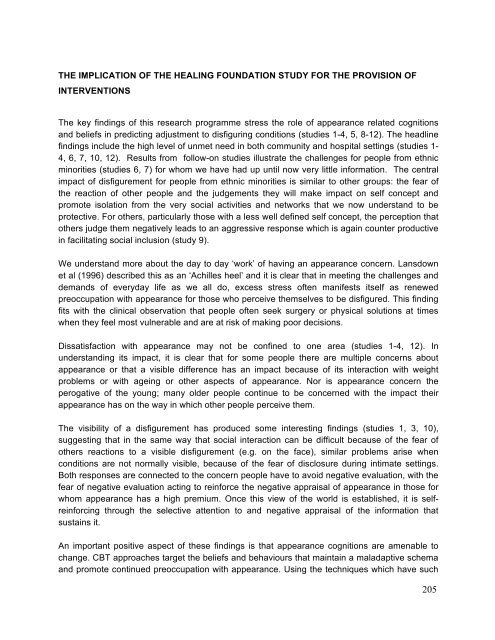Download the report - The Healing Foundation
Download the report - The Healing Foundation
Download the report - The Healing Foundation
You also want an ePaper? Increase the reach of your titles
YUMPU automatically turns print PDFs into web optimized ePapers that Google loves.
THE IMPLICATION OF THE HEALING FOUNDATION STUDY FOR THE PROVISION OF<br />
INTERVENTIONS<br />
<strong>The</strong> key findings of this research programme stress <strong>the</strong> role of appearance related cognitions<br />
and beliefs in predicting adjustment to disfiguring conditions (studies 1-4, 5, 8-12). <strong>The</strong> headline<br />
findings include <strong>the</strong> high level of unmet need in both community and hospital settings (studies 1-<br />
4, 6, 7, 10, 12). Results from follow-on studies illustrate <strong>the</strong> challenges for people from ethnic<br />
minorities (studies 6, 7) for whom we have had up until now very little information. <strong>The</strong> central<br />
impact of disfigurement for people from ethnic minorities is similar to o<strong>the</strong>r groups: <strong>the</strong> fear of<br />
<strong>the</strong> reaction of o<strong>the</strong>r people and <strong>the</strong> judgements <strong>the</strong>y will make impact on self concept and<br />
promote isolation from <strong>the</strong> very social activities and networks that we now understand to be<br />
protective. For o<strong>the</strong>rs, particularly those with a less well defined self concept, <strong>the</strong> perception that<br />
o<strong>the</strong>rs judge <strong>the</strong>m negatively leads to an aggressive response which is again counter productive<br />
in facilitating social inclusion (study 9).<br />
We understand more about <strong>the</strong> day to day ‘work’ of having an appearance concern. Lansdown<br />
et al (1996) described this as an ‘Achilles heel’ and it is clear that in meeting <strong>the</strong> challenges and<br />
demands of everyday life as we all do, excess stress often manifests itself as renewed<br />
preoccupation with appearance for those who perceive <strong>the</strong>mselves to be disfigured. This finding<br />
fits with <strong>the</strong> clinical observation that people often seek surgery or physical solutions at times<br />
when <strong>the</strong>y feel most vulnerable and are at risk of making poor decisions.<br />
Dissatisfaction with appearance may not be confined to one area (studies 1-4, 12). In<br />
understanding its impact, it is clear that for some people <strong>the</strong>re are multiple concerns about<br />
appearance or that a visible difference has an impact because of its interaction with weight<br />
problems or with ageing or o<strong>the</strong>r aspects of appearance. Nor is appearance concern <strong>the</strong><br />
perogative of <strong>the</strong> young; many older people continue to be concerned with <strong>the</strong> impact <strong>the</strong>ir<br />
appearance has on <strong>the</strong> way in which o<strong>the</strong>r people perceive <strong>the</strong>m.<br />
<strong>The</strong> visibility of a disfigurement has produced some interesting findings (studies 1, 3, 10),<br />
suggesting that in <strong>the</strong> same way that social interaction can be difficult because of <strong>the</strong> fear of<br />
o<strong>the</strong>rs reactions to a visible disfigurement (e.g. on <strong>the</strong> face), similar problems arise when<br />
conditions are not normally visible, because of <strong>the</strong> fear of disclosure during intimate settings.<br />
Both responses are connected to <strong>the</strong> concern people have to avoid negative evaluation, with <strong>the</strong><br />
fear of negative evaluation acting to reinforce <strong>the</strong> negative appraisal of appearance in those for<br />
whom appearance has a high premium. Once this view of <strong>the</strong> world is established, it is selfreinforcing<br />
through <strong>the</strong> selective attention to and negative appraisal of <strong>the</strong> information that<br />
sustains it.<br />
An important positive aspect of <strong>the</strong>se findings is that appearance cognitions are amenable to<br />
change. CBT approaches target <strong>the</strong> beliefs and behaviours that maintain a maladaptive schema<br />
and promote continued preoccupation with appearance. Using <strong>the</strong> techniques which have such<br />
205


